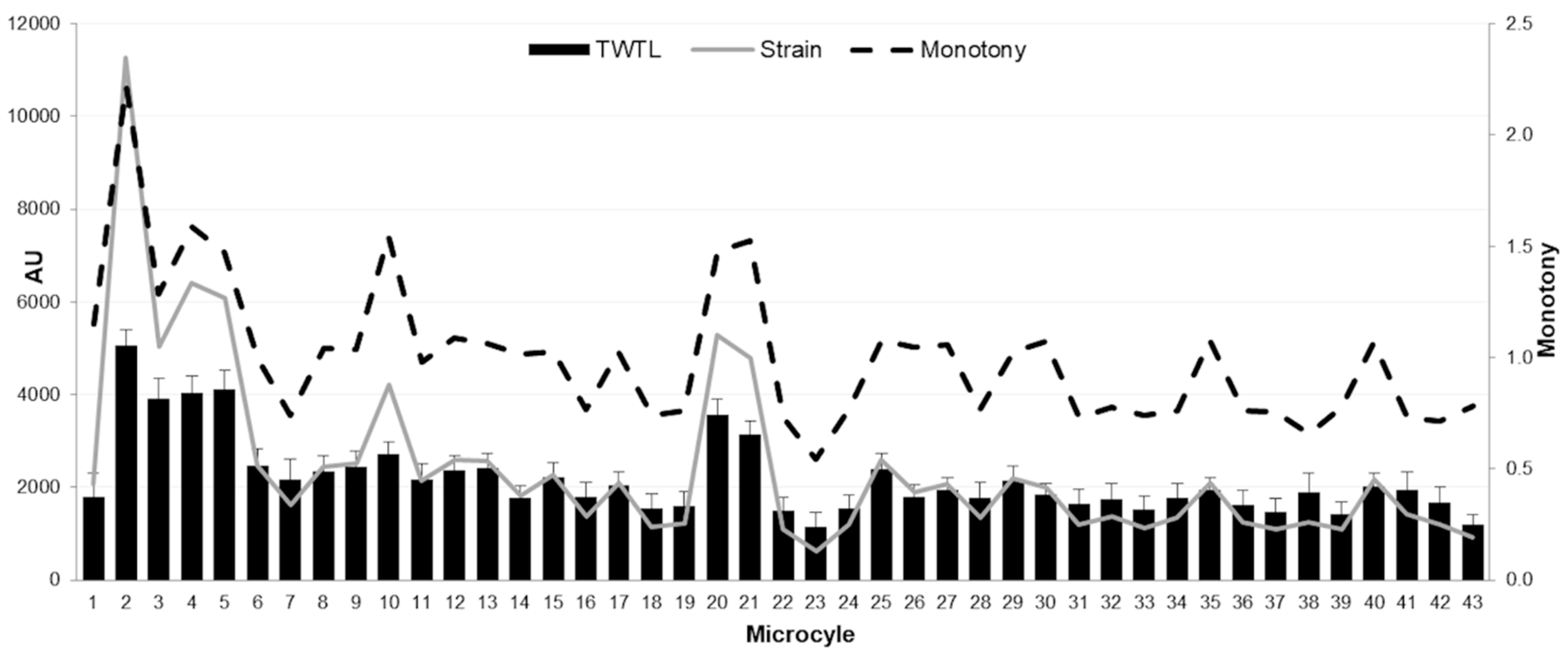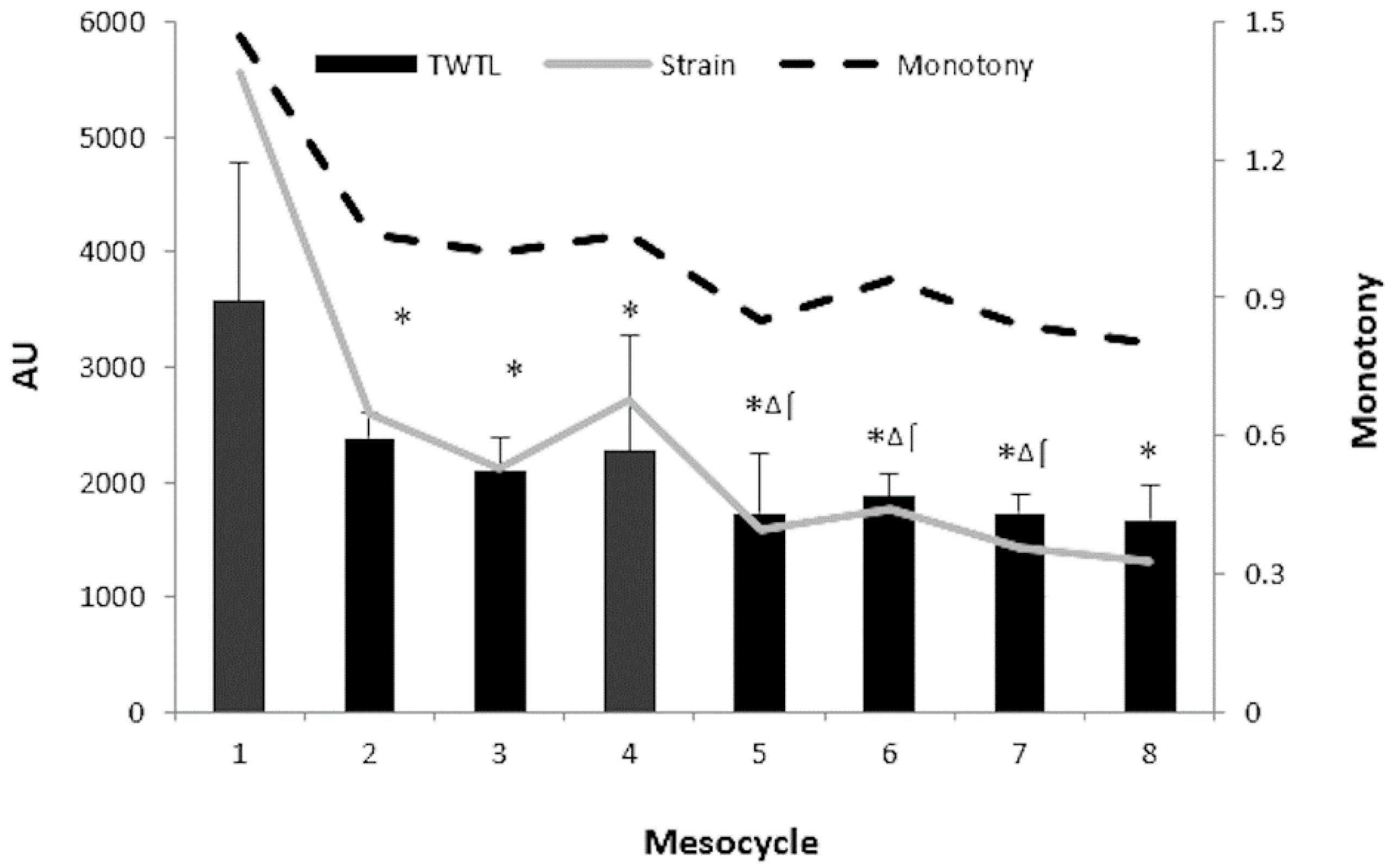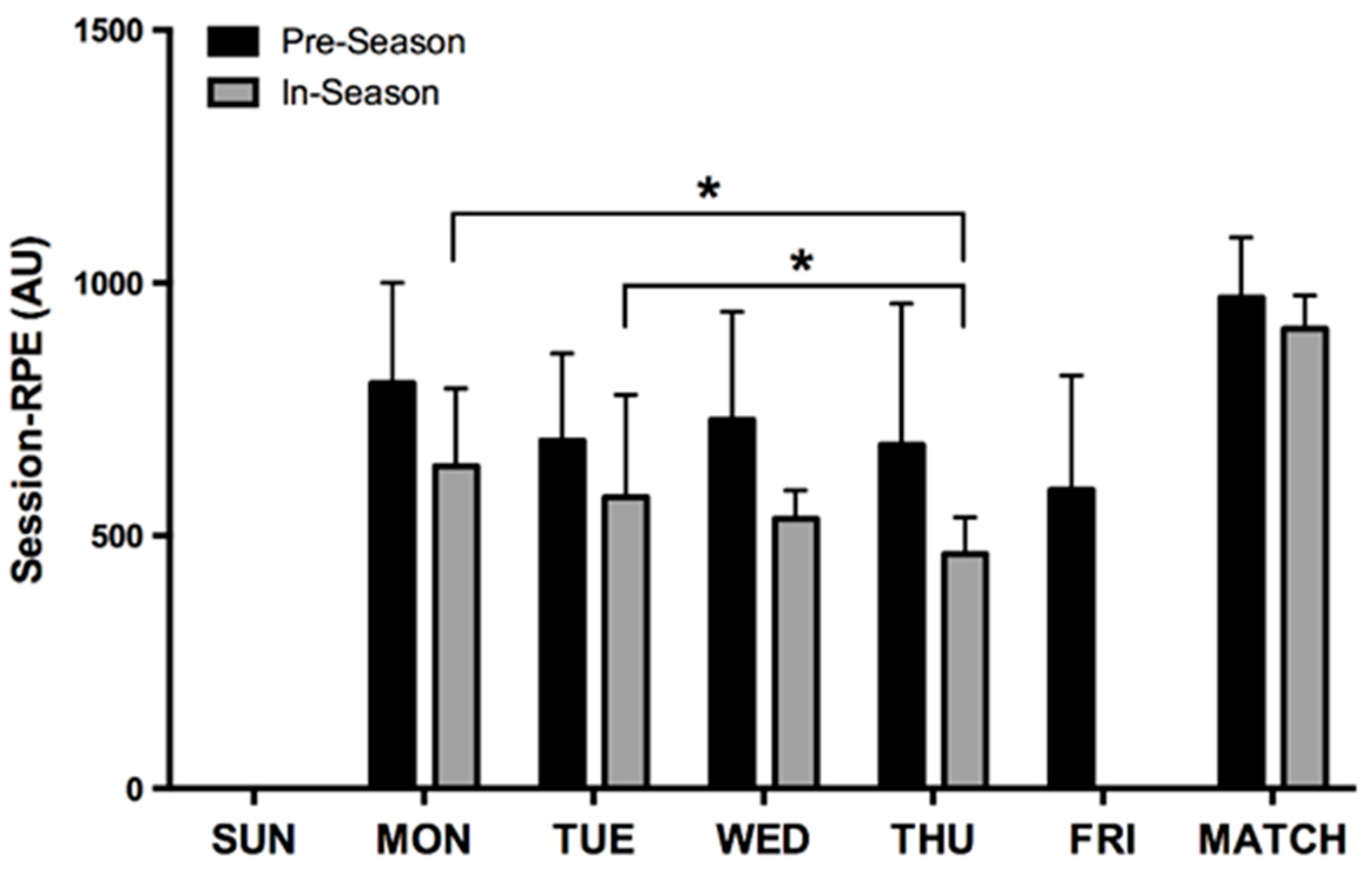Monitoring Workloads of a Professional Female Futsal Team over a Season: A Case Study
Abstract
:1. Introduction
2. Materials and Methods
2.1. Study Design
2.2. Participants
2.3. Procedures
2.4. Statistical Analysis
3. Results
4. Discussion
5. Conclusions
Practical Recommendations
Author Contributions
Funding
Acknowledgments
Conflicts of Interest
References
- FIFA. Women’s Football Strategy. 2018. Available online: https://resources.fifa.com/image/upload/.women-s-football-strategy.pdf?cloudid=z7w21ghir8jb9tguvbcq (accessed on 13 October 2018).
- Vanrenterghem, J.; Nedergaard, N.J.; Robinson, M.A.; Drust, B. Training Load Monitoring in Team Sports: A Novel Framework Separating Physiological and Biomechanical Load-Adaptation Pathways. Sports Med. 2017, 47, 2135–2142. [Google Scholar] [CrossRef] [PubMed]
- Cross, M.J.; Williams, S.; Trewartha, G.; Kemp, S.; Stokes, K.A. The Influence of In-Season Training Loads on Injury Risk in Professional Rugby Union. Int. J. Sports Physiol. Perform. 2016, 11, 350–355. [Google Scholar] [CrossRef] [PubMed] [Green Version]
- Da Rocha, R.E.R.; Nunes, E.; Venera, G.D. Selective loads periodization attenuates biochemical disturbances and enhances performance in female futsal players during competitive season. Mot. Rev. Educ. Física 2015, 21, 158–167. [Google Scholar] [CrossRef]
- Nakamura, F.Y.; Pereira, L.; Rabelo, F.N.; Flatt, A.A.; Esco, M.R.; Bertollo, M.; LoTurco, I. Monitoring weekly heart rate variability in futsal players during the preseason: The importance of maintaining high vagal activity. J. Sports Sci. 2016, 34, 2262–2268. [Google Scholar] [CrossRef]
- Milanez, V.F.; Pedro, R.E.; Moreira, A.; Boullosa, D.; Salle-Neto, F.; Nakamura, F.Y. The Role of Aerobic Fitness on Session Rating of Perceived Exertion in Futsal Players. Int. J. Sports Physiol. Perform. 2011, 6, 358–366. [Google Scholar] [CrossRef] [Green Version]
- Moreira, A.; De Moura, N.R.; Coutts, A.; Costa, E.C.; Kempton, T.; Aoki, M.S. Monitoring Internal Training Load and Mucosal Immune Responses in Futsal Athletes. J. Strength Cond. Res. 2013, 27, 1253–1259. [Google Scholar] [CrossRef]
- Teixeira, A.S.; Nunes, R.F.H.; Yanci, J.; Izzicupo, P.; Flores, L.J.F.; Romano, J.C.; Guglielmo, L.G.A.; Nakamura, F.Y. Different Pathways Leading up to the Same Futsal Competition: Individual and Inter-Team Variability in Loading Patterns and Preseason Training Adaptations. Sports 2018, 7, 7. [Google Scholar] [CrossRef] [Green Version]
- Wilke, C.F.; Ramos, G.P.; Pacheco, D.A.; Santos, W.H.; Diniz, M.S.; Gonçalves, G.G.; Marins, J.C.; Wanner, S.; Silami-Garcia, E. Metabolic Demand and Internal Training Load in Technical-Tactical Training Sessions of Professional Futsal Players. J. Strength Cond. Res. 2016, 30, 2330–2340. [Google Scholar] [CrossRef]
- Haddad, M.; Stylianides, G.; Djaoui, L.; Dellal, A.; Chamari, K. Session-RPE Method for Training Load Monitoring: Validity, Ecological Usefulness, and Influencing Factors. Front. Mol. Neurosci. 2017, 11. [Google Scholar] [CrossRef]
- de Freitas, V.H.; Miloski, B.; Bara Filho, M.G. Quantification of training load using session RPE method and performance in futsal. Rev. Bras. Cineantropometria Desempenho Hum. 2012, 14, 73–82. [Google Scholar]
- Miloski, B.; de Freitas, V.; Bara Filho, M.G. Monitoring of the internal training load in futsal players over a season. Rev. Bras. Cineantropometria Desempenho Hum. 2012, 14, 671–967. [Google Scholar]
- Clemente, F.M.; Nikolaidis, P.T. Profile of 1-month training load in male and female football and futsal players. SpringerPlus 2016, 5, 694. [Google Scholar] [CrossRef] [PubMed] [Green Version]
- Nakamura, F.Y.; Pereira, L.; Rabelo, F.N.; Ramirez-Campillo, R.; LoTurco, I. Faster Futsal Players Perceive Higher Training Loads and Present Greater Decreases in Sprinting Speed During the Preseason. J. Strength Cond. Res. 2016, 30, 1553–1562. [Google Scholar] [CrossRef] [PubMed]
- Álvarez Medina, J.; Murillo Lorente, V. Comparison of planned and executed loads in futsal training: The double scale. RETOSNuevas Tendencias en Educ Física Deport y Recreación 2016, 29, 48–52. [Google Scholar]
- Borg, G. Borg ́s Perceived Exertion and Pain Scales; Human Kinetics: Champaign, IL, USA, 1998. [Google Scholar]
- Foster, C. Monitoring training in athletes with reference to overtraining syndrome. Med. Sci. Sports Exerc. 1998, 30, 1164–1168. [Google Scholar] [CrossRef]
- Batterham, A.; Hopkins, W.G. Making Meaningful Inferences About Magnitudes. Int. J. Sports Physiol. Perform. 2006, 1, 50–57. [Google Scholar] [CrossRef]
- Coyne, J.O.C.; Haff, G.G.; Coutts, A.J.; Newton, R.; Nimphius, S. The Current State of Subjective Training Load Monitoring—a Practical Perspective and Call to Action. Sports Med.-Open 2018, 4, 58. [Google Scholar] [CrossRef] [Green Version]
- Rabelo, F.N.; Pasquarelli, B.N.; Gonçalves, B.; Matzenbacher, F.; Campos, F.A.D.; Sampaio, J.; Nakamura, F.Y. Monitoring the Intended and Perceived Training Load of a Professional Futsal Team Over 45 Weeks. J. Strength Cond. Res. 2016, 30, 134–140. [Google Scholar] [CrossRef]
- Scott, B.; Lockie, R.G.; Knight, T.J.; Clark, A.C.; De Jonge, X.J. A Comparison of Methods to Quantify the In-Season Training Load of Professional Soccer Players. Int. J. Sports Physiol. Perform. 2013, 8, 195–202. [Google Scholar] [CrossRef] [Green Version]
- Casamichana, D.; Castellano, J.; Calleja-González, J.; Román, J.S.; Castagna, C. Relationship Between Indicators of Training Load in Soccer Players. J. Strength Cond. Res. 2013, 27, 369–374. [Google Scholar] [CrossRef]
- Moreira, A.; McGuigan, M.R.; Arruda, A.; Freitas, C.G.; Aoki, M.S. Monitoring Internal Load Parameters During Simulated and Official Basketball Matches. J. Strength Cond. Res. 2012, 26, 861–866. [Google Scholar] [CrossRef] [PubMed]
- Flatt, A.A.; Esco, M.R. Smartphone-Derived Heart-Rate Variability and Training Load in a Women’s Soccer Team. Int. J. Sports Physiol. Perform. 2015, 10, 994–1000. [Google Scholar] [CrossRef]
- Nunes, J.A.; Moreira, A.; Crewther, B.T.; Nosaka, K.; Viveiros, L.; Aoki, M.S. Monitoring Training Load, Recovery-Stress State, Immune-Endocrine Responses, and Physical Performance in Elite Female Basketball Players During a Periodized Training Program. J. Strength Cond. Res. 2014, 28, 2973–2980. [Google Scholar] [CrossRef] [PubMed]
- Varamenti, E.I.; Kyparos, A.; Veskoukis, A.S.; Bakou, M.; Kalaboka, S.; Jamurtas, A.Z.; Koutedakis, Y.; Kouretas, D. Oxidative stress, inflammation and angiogenesis markers in elite female water polo athletes throughout a season. Food Chem. Toxicol. 2013, 61, 3–8. [Google Scholar] [CrossRef] [PubMed]
- Milanez, V.F.; Ramos, S.P.; Okuno, N.M.; Boullosa, D.A.; Nakamura, F.Y. Evidence of a Non-Linear Dose-Response Relationship between Training Load and Stress Markers in Elite Female Futsal Players. J. Sports Sci. Med. 2014, 13, 22–29. [Google Scholar]
- Impellizzeri, F.M.; Rampinini, E.; Coutts, A.J.; Sassi, A.; Marcora, S. Use of RPE-Based Training Load in Soccer. Med. Sci. Sports Exerc. 2004, 36, 1042–1047. [Google Scholar] [CrossRef]
- Ramos-Campo, D.J.; Rubio-Arias, J.Á.; Carrasco-Poyatos, M.; Alcaraz, P.E. Physical performance of elite and subelite Spanish female futsal players. Biol. Sport 2016, 33, 297–304. [Google Scholar] [CrossRef]



| Mesocycle | 1 | 2 | 3 | 4 | 5 | 6 | 7 | 8 |
|---|---|---|---|---|---|---|---|---|
| Type | IL | ML | DL | IL | DL | IL | ML | ML |
| Weeks | 6 | 5 | 7 | 5 | 4 | 5 | 5 | 6 |
| Matches | 7 | 5 | 6 | 1 | 4 | 5 | 5 | 6 |
| Period | PP | CP | CP | PP | CP | CP | CP | CP |
| Strength | 315 | 60 | 70 | 22 | 20 | 30 | 10 | 0 |
| Power | 95 | 105 | 100 | 85 | 85 | 75 | 70 | 60 |
| Specific Endurance | 585 | 145 | 270 | 290 | 80 | 210 | 160 | 125 |
| Preventive | 490 | 480 | 415 | 235 | 245 | 260 | 205 | 305 |
| Technical-Tactical | 1620 | 915 | 1165 | 775 | 860 | 935 | 815 | 1090 |
| Emotive-volitional | 655 | 430 | 515 | 200 | 225 | 275 | 350 | 270 |
© 2020 by the authors. Licensee MDPI, Basel, Switzerland. This article is an open access article distributed under the terms and conditions of the Creative Commons Attribution (CC BY) license (http://creativecommons.org/licenses/by/4.0/).
Share and Cite
Lago-Fuentes, C.; Jiménez-Loaisa, A.; Padrón-Cabo, A.; Fernández-Villarino, M.; Mecías-Calvo, M.; Travassos, B.; Rey, E. Monitoring Workloads of a Professional Female Futsal Team over a Season: A Case Study. Sports 2020, 8, 69. https://doi.org/10.3390/sports8050069
Lago-Fuentes C, Jiménez-Loaisa A, Padrón-Cabo A, Fernández-Villarino M, Mecías-Calvo M, Travassos B, Rey E. Monitoring Workloads of a Professional Female Futsal Team over a Season: A Case Study. Sports. 2020; 8(5):69. https://doi.org/10.3390/sports8050069
Chicago/Turabian StyleLago-Fuentes, Carlos, Alejandro Jiménez-Loaisa, Alexis Padrón-Cabo, Marián Fernández-Villarino, Marcos Mecías-Calvo, Bruno Travassos, and Ezequiel Rey. 2020. "Monitoring Workloads of a Professional Female Futsal Team over a Season: A Case Study" Sports 8, no. 5: 69. https://doi.org/10.3390/sports8050069
APA StyleLago-Fuentes, C., Jiménez-Loaisa, A., Padrón-Cabo, A., Fernández-Villarino, M., Mecías-Calvo, M., Travassos, B., & Rey, E. (2020). Monitoring Workloads of a Professional Female Futsal Team over a Season: A Case Study. Sports, 8(5), 69. https://doi.org/10.3390/sports8050069







